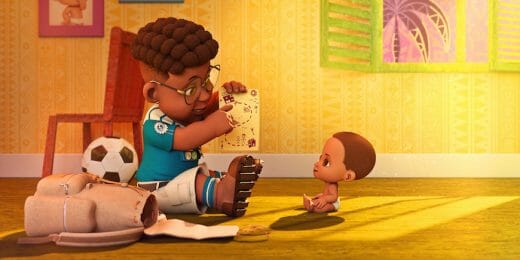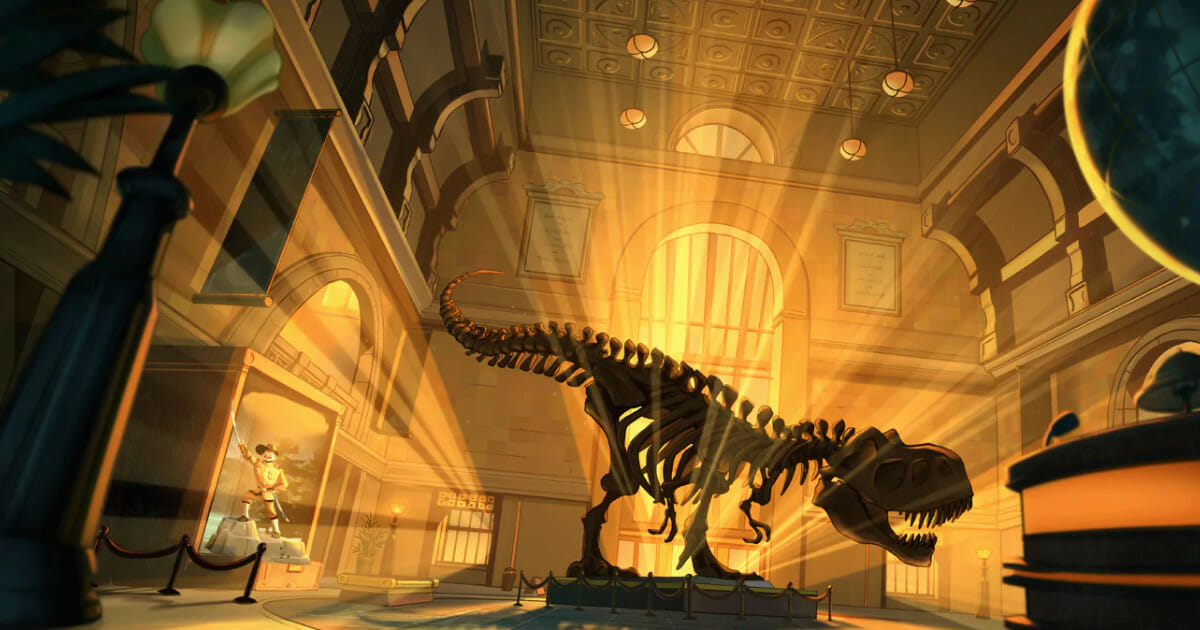
Set between Battle of the Smithsonian and Secret of the Tomb, Night at the Museum: Kahmunrah Rises Again follows Larry Daley’s son, Nick, on his adventures as a fledgeling night guard at the Natural History Museum in Manhattan. Fan-favourite wax figures from previous films return, including Teddy Roosevelt and Sacagawea, along with new additions such as Joan of Arc. As the series’ first foray into animation, the medium creates new opportunities to play up the action and comedy that audiences expect from the Night at the Museum films.
We had the chance to interview director Justin Lovell at Atomic Cartoons to discuss the film’s ambitious animated scenes, the production’s approach to sound and lighting in 2D animation as well as the challenges of expanding on a preexisting cinematic world.
What did a typical day in production look like for you?
Justin: A typical day in production involved lots of meetings and problem-solving, because we were constantly trying to push bits and pieces. Being who I am, I found I was doing a lot of odd-jobs as well. I came up through animation into this role. I would find myself jumping into shots and helping out the animation team or helping out the retakes team. So I would plug myself in where I was needed to help move the project along.
The day was just a lot of making sure the project stayed on-track, whether it be problems from the technical side or facing creative stuff.
What did the creative brief for this project look like?
Justin: There were a lot of things that we wanted to do that were obviously going to keep it different from the original three [films], because they were live-action and we went with animation. We wanted to make it something that stood within the universe [of the first three films] but was also its own thing.
It was a little rough because you do have all these legacy ideas that we were locked into. How do we take those and push them? The creative brief was about rethinking the stories and pushing the boundaries of what we could do within that universe. We didn’t want to do a reboot. We wanted to make sure this was something that stood on its own feet.
We’re bringing the cast back, so we made sure that they were true to who they were and what they represented. And then we were able to bring in Joan of Arc, a brand new character. She’s quite layered, she’s very funny and she’d be the first into a fight.
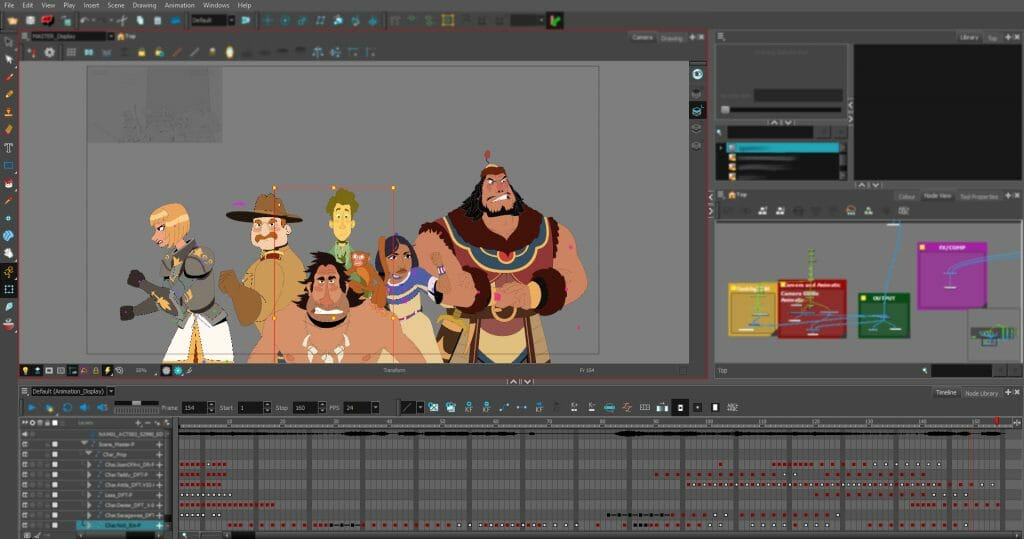
How familiar was the crew with the Night at the Museum film series before starting production?
Justin: They were pretty familiar. A lot of the people I’d spoken to beforehand, if they hadn’t watched it, they were leaving those meetings to watch it straightaway. You had to watch the first two films before you started. Our film sits between the second and third film, as McPhee hasn’t realized the tablet is magical.
A lot of the younger artists hadn’t seen the films. We made sure everyone was well-informed of who these characters were, what they stood for and their dynamics. And we had a lot of interest from people who were fans and in the industry. They were putting their hands up. It was cool to see the fans jump in and play around with the characters.
What techniques and programs did you use in animating this project?
Justin: Toon Boom. Lots of Toon Boom. All the Toon Boom. With our pre-vis, staging and our storyboards, we went with Storyboard Pro. For our builds, animation, effects, comp, all that was Harmony. Everything was pretty much Toon Boom products, minus a five-to-seven percent where we used Maya and After Effects. But a huge portion of this film was made directly in Toon Boom products.
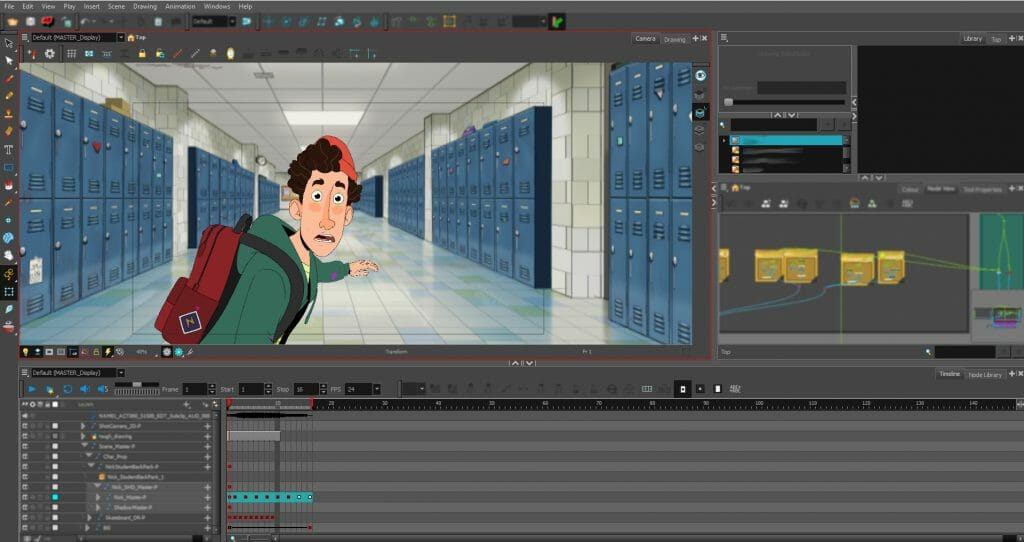
The film starts with a long zoom through Manhattan to the museum. What were the challenges in executing such an involved shot?
Justin: The first challenge was getting everyone on board. For that shot, everyone was a little scared. I wanted something big to open the film, to put butts in seats. I knew that if we got [the opening] wrong, people would just turn off and be onto whatever’s next. For the planning, I sat down with one of our technical directors, Juan Carlos, and we went through the stages.
From the very top of the shot, as we go down into the buildings, into Times Square, and just as we pushed through the taxi right at the beginning, that was all Maya projections. And then from the cab, all the way through into the museum, and pretty much all the rest of the film was done in Harmony.
We figured out that we needed five different sets. And then once those sets were animated, we went to comp. A very brave soul, Shannon Hamilton, was one of our composting leads, and he stitched everything together.
We spent countless days going through and making sure the speeds were correct, making sure everything was moving correctly and working nicely. From start to finish, it was the very first shot that we started with and it was the very last shot we ended up delivering. It was so involved.
Juan and I sat there and we had to set up each set from start to finish — where the characters would be, what they would be doing, making sure the speeds were all consistent throughout. Once we had the cameras working for all five individual shots, we sent that out to the animators, and the animators were animating within those little environments. Once we had those environments working, that’s where Shannon would come in and stitch everything together.
It’s the biggest shot, and it was definitely a challenge. But it looks good. I think when everybody saw the final result, they were blown away with what we were able to achieve.
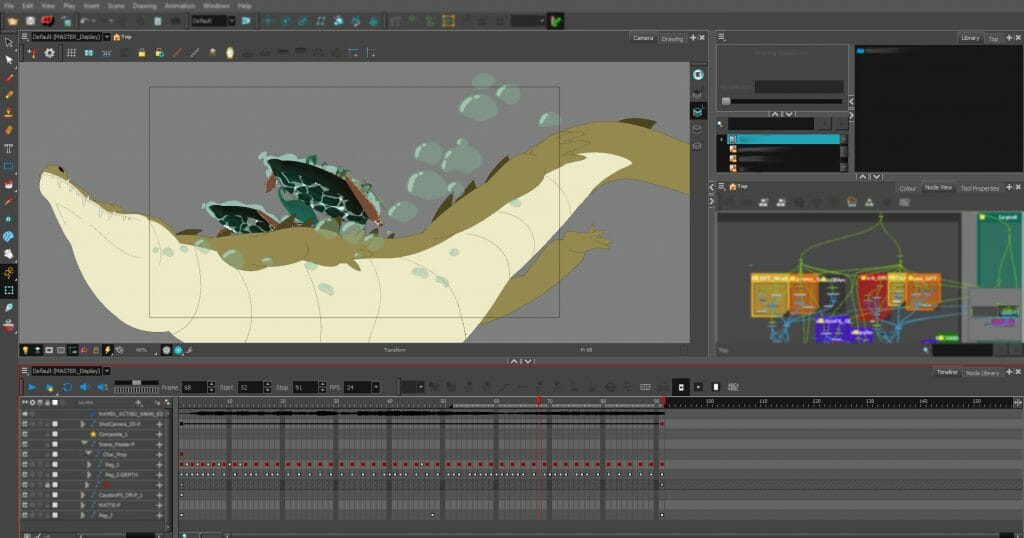
Which part of the project was the most interesting or challenging to animate?
Justin: There was one shot that I love above all else. It was something that I wanted to put together as part of the action sequence right at the end. There’s a shot where the [flashlight] drops out of Nick’s bag and he realizes, “Oh, maybe this can help fend off all these Anubis warriors.”
So he picks it up and he starts throwing it to the gang. I choreographed this shot that I really wanted to do in one shot and I don’t think anyone was going to talk me off the cliff for this one. I sat there asking, “What can we do to make sure this feels like one continuous shot?”
What I came up with was, instead of keeping the camera wide, let’s follow the prop. Let’s follow the flashlight as it’s getting thrown to each character as we go through it and then end with that nice ‘Avengers poster shot.’ That shot ended up looking exactly how I envisioned it. The animators did a crazy job of getting that done. It’s something that I took a lot of pride in watching. There’s some animation that really stands out within that shot.
When you’re in these fight sequences, it’s very easy to cut-cut-cut-cut-cut, and keep everything moving super-fast. I wanted something in there that was a little more slower-paced so you could really get a feel of weight to what was going on. I’m really glad that it came together the way that it did.
What were the challenges in adapting live-action characters and settings for animation?
Justin: The biggest challenge was probably with the sets — making sure that people could see the relationship between the 2D and the live action. When we’re in the museum, our home base, we wanted to make sure we had a lot of golds. We did our best to replicate the feel, the warmth, that the original film had. That was our biggest challenge. Our art director, Rebecca Dart, did such an amazing job of matching that up.
And the same with the characters. We’ve taken from the live action, made sure that we’re referencing these films. For Teddy [Roosevelt], we pushed him a little bit because he can be quite big and broad. We made him a bit more theatrical, while still keeping him contained within that Teddy feel. We tried to do that with every character. It’s a very fine line, we found, just making sure we were staying true to Shawn Levy and the live action movies. We also wanted to make it exciting as well.
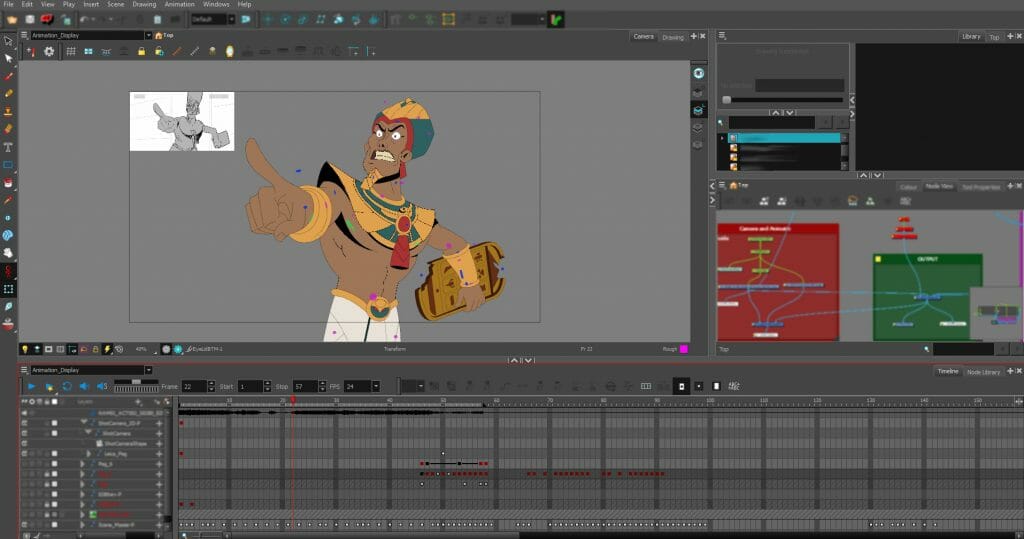
The lighting and shadows really stand out in this movie. What are the challenges and benefits to incorporating dynamic lighting?
Justin: For the characters, we wanted to reference old French comics, where they had that nice black shadow. We tried to incorporate that very early on, referencing comics throughout when we were designing our backgrounds and our stages, to keep them in the world. The dynamic lighting evolved from there.
We really wanted to push what the viewer’s looking at, to make sure it felt cinematic. We wanted to make sure that the world felt big. That was one thing that I really wanted to push very early on. When we’re in the middle of nowhere, I wanted it to feel like we’re in the middle of nowhere. And when we go into Ancient Egypt, you can feel how vast the desert is.
So when we go to the second museum, you can see how big it is. We go into the foyer, and start walking around, into the temples. I wanted to make sure that everything looked big. We needed the lighting to support that as well.
Even shots like the sequence with the crocodile, where we’re jumping up and down above water and below water, we really pushed the lighting there so that everything’s nice and close. It’s going to be dark and blurry, just so we can focus on what’s going on in the midground. We made sure the background was blurred out so the viewer can get a sense of depth.
The lighting definitely helped us push where we wanted to take the film to, which was making it feel a lot more theatrical, making sure we thought about our cinematography, and making sure everything was married within the world. It’s always a little rough when you see characters that don’t quite blend into the world that they’re supposed to be in.
The sound design is another stand-out element in this film. What role does sound play in creating an animated environment?
Justin: I feel that sound is something that can be overlooked, but it is something that can change the whole tone of the scene. It was so important to make sure that we were using the right sound, using the right music and sound effects.
It’s so crucial because if you don’t hit the right tone, you’re not going to get that impact that you might have gotten if you used something else. You really want to make sure you’re quite detail-oriented when it comes to that sort of stuff.
If you have a happy scene, you want to make sure that the music’s upbeat, that you can hear as well as see that. If you have a pivotal moment, and all of the sudden you’ve got these upbeat tunes in the background, that pivotal moment just doesn’t hit as hard. Making sure that we used the right sound, really thinking about what we were doing there, is very important.
I do believe it’s half the battle when it comes to putting together an animated project. We can almost do a film, and we’ve seen it, without dialogue. You can just have the characters go through that emotion with the soundtrack really pushing out the emotion of what the characters are going through. Yeah, sound is super important.
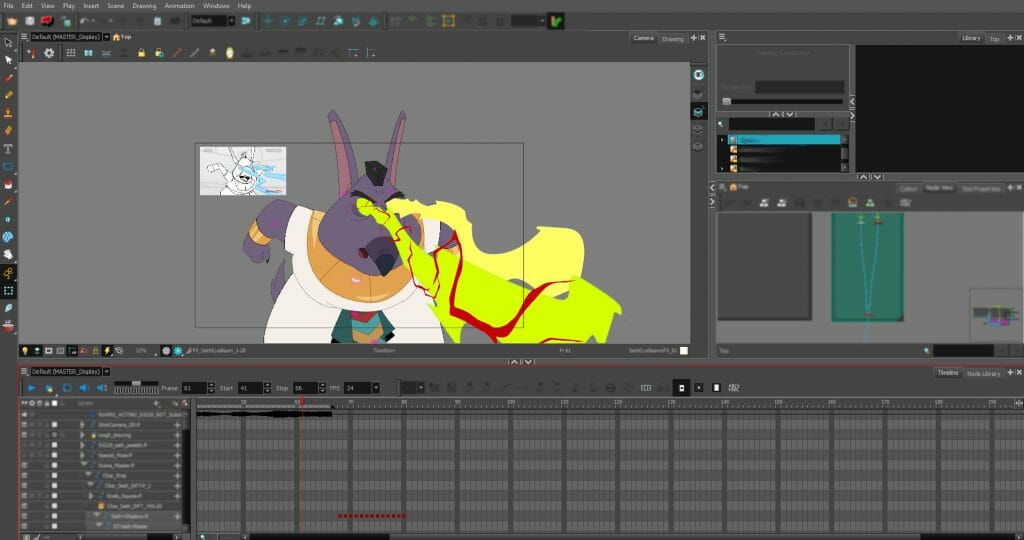
How would you describe the reaction to the film?
Justin: A lot of positivity. I’ll be honest, I was a little worried because we’re coming from live action into a 2D film. Even while trying to be its own thing, I was worried it might not be well-received. Overall, I’ve seen really positive messages and reviews. From what I’ve seen, it looks good.
- Ready to watch the animated adventure? Night at the Museum: Kahmunrah Rises Again is available to stream on Disney+.
- Can you animate characters without relying on a cursed artifact? Join the team at Atomic Cartoons.
- Looking for more of Justin Lovell’s work? His portfolio can be found online at justinlovellanimation.com.



